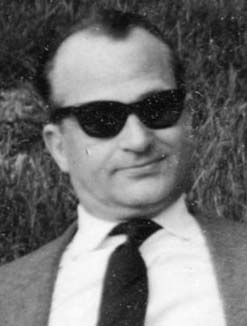
Emilio Baiada
 المؤلف:
C Vinti
المؤلف:
C Vinti
 المصدر:
Emilio Baiada (1914-1984)
المصدر:
Emilio Baiada (1914-1984)
 الجزء والصفحة:
...
الجزء والصفحة:
...
 26-11-2017
26-11-2017
 544
544
Born: 12 January 1914 in Tunis, Tunisia
Died: 14 May 1984 in Modena, Italy

Emilio Baiada attended the Scuola Normale Superiore di Pisa where he studied for his laurea with Leonida Tonelli as his thesis advisor. The laurea was the highest degree in Italy at the time - it required the candidate to submit a dissertation and was essentially a doctorate. Not only did Baiada receive the laurea but he was awarded the Michel Prize for best dissertation. After receiving the degree in June 1937, he worked as Tonelli's assistant at the Scuola Normale Superiore di Pisa from 1938 to 1941, publishing papers such as Osservazioni sulla misurabilità secondo Carathéodory (1939) and Sopra un problema di Mayer(1940). In 1940 he received the Merlani Award for "contributions relating to the calculus of variations". At this point, Italy having entered World War II, he was called up for military service.
Normally military service lasted two years but, with World War II in progress, it was often the case that people remained in military service until the war ended and, in Baiada's case, this is what happened. However, he was still able to submit some work for publication during the war years: for example Un problema non regolare del calcolo delle variazioni (1942), Sul teorema d'esistenza per le equazioni alle derivate parziali del primo ordine (1943), Sur problema di Cauchy per le equazioni alle derivate parziali (1943) and Sopra un problema non regolare e un problema isoperimetrico del calcolo delle variazioni (1944). We note that, because of disruption caused by the war, the papers given as 1943 did not actually appear in print until 1946 and the 1944 paper only appeared in 1947.
After the war ended, Baiada returned to his position at the Scuola Normale Superiore in Pisa. Although not formally qualified as a lecturer at this stage, nevertheless he taught the analysis courses, namely the theory of functions, calculus, and rational mechanics. In 1948 he qualified as a lecturer in analysis and, at the end of 1949 he obtained leave of absence from the Scuola Normale Superiore and was appointed to a visiting professorship at the University of Cincinnati in the United States. In Cincinnati he worked closely with the analysts Otto Szász and Charles Napoleon Moore (1882-1967), who was a native of Cincinnati and had been a student of Maxime Bôcher. Baiada attended the four hundred sixty-fifth meeting of the American Mathematical Society which was held at the University of Cincinnati on Friday and Saturday 23-24 February 1951. Following this he was a member of the Institute for Advanced Study at Princeton where he worked with Marston Morse. They collaborated on a joint paper Homotopy and Homology Related to the Schoenflies Problem which was published in the Annals of Mathematics in 1953.
In 1952, after taking part in a competition for the Chair of Analysis at the University of Palermo, Baiada took up the position. He had already worked with Calogero Vinti so, when he was appointed to Palermo, the two mathematicians began a close collaboration. They jointly published the 45-page paper Un teorema d'esistenza della soluzione per un'equazione alle derivate parziali del 1 ordine in 1955 and also Un'applicazione della definizione di integrale per stabilire un passaggio al limite sotto il segno in the same year. The first of these papers gives an existence theorem for the equation zx = f (x, y, z, zy) using methods which had been developed by Baiada a couple of years earlier in solving a simpler equation. This was a very active period for Baiada who, also in 1955, published the single-authored paper La limitatezza, gli zeri di una funzione e i coefficienti di Eulero-Fourier. Alberto Calderón reviewed this paper, writing:-
The author uses the results of Toeplitz and Carathéodory concerning the coefficients of the Fourier-Stieltjes series of a non-decreasing function and some theorems of Ghizzetti concerning the coefficients of a function between given bounds in order to characterize functions which are i) non-negative, ii)with values between 0 and 1, iii) positive and bounded away from zero. Further the author gives necessary and sufficient conditions (also in terms of the Fourier coefficients) in order that, given a function of bounded variation, it be possible to decompose (0, 2) into m intervals over each of which the function is non-negative or non-positive. It is shown that a theorem of Hurwitz concerning the number of zeros of a continuous function of bounded variation whose first 2k+1 Fourier coefficients vanish is a consequence of these results.
Baiada also did important work with Vinti on perimeters of sets. They presented some of their results on this topic in the paper Generalizzazione non markoviana della definizione di perimetro given at the Celebrazioni Archimedee del Sec. XX in Syracuse in 1961. It is worth noting that this was just one of three jointly authored papers that Baiada published in the Proceedings of this Syracuse conference. Baiada left Palermo in 1961 and moved to Modena in when he was appointed Professor of Mathematical Analysis at the University of Modena. At Modena he worked hard to bring the Institute of Mathematics up to an international centre of excellence. He also built up the library of the Institute and raised the standard of the Mathematical Seminar there.
We have mentioned some of Baiada's publications above but we note that his output totals 60 scientific publications on a wide range of different fields in analysis: ordinary and partial differential equations, Fourier series and the series expansion of orthonormal functions, topology, real analysis, functional analysis, calculus of variations, measure and integration, optimisation, and the theory of functions.
Articles:
- C Vinti, Emilio Baiada (1914-1984) (Italian), Atti Sem. Mat. Fis. Univ. Modena 33 (1) (1984), iii-xiv.
 الاكثر قراءة في 1910to1914
الاكثر قراءة في 1910to1914
 اخر الاخبار
اخر الاخبار
اخبار العتبة العباسية المقدسة


